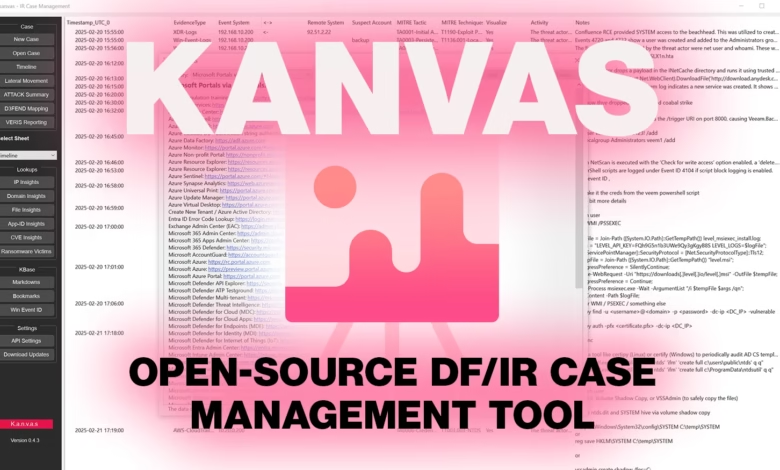Kanvas: Open-Source Incident Response Tool for Teams

▼ Summary
– Kanvas is an open-source Python-based incident response tool that simplifies case management by allowing investigators to work with spreadsheet files in a single interface.
– The tool uses Excel as its backend and includes Markdown-based note-taking features, enabling structured, portable notes that can be exported or shared easily.
– It supports external lookups and offers data visualization capabilities, such as generating timelines and MITRE D3FEND matrix mappings, to streamline investigations and reporting.
– Future updates will introduce new visualizations, Diamond Model mapping, LLM-powered reporting, and integrations with threat intelligence platforms like MISP and OpenCTI.
– Kanvas is freely available on GitHub, with planned UI enhancements for macOS users to improve usability and performance.
Kanvas revolutionizes incident response with its open-source case management solution, streamlining investigations through a Python-built desktop interface. This powerful tool eliminates the need to juggle multiple applications by providing investigators with a centralized workspace for handling SOD files and similar documents.
Developed by a senior incident response investigator, Kanvas utilizes Excel as its backend, ensuring seamless compatibility with existing workflows. One of its standout features is Markdown-based note-taking, allowing analysts to create structured, portable documentation that remains accessible even outside the tool. These notes can be effortlessly exported in .md format, simplifying collaboration and reporting.
The platform excels in external lookups, enabling investigators to enrich case data without switching between applications. Visualization capabilities set Kanvas apart, timelines and lateral movement patterns can be generated instantly with a single click, then exported as images for reports and presentations. Additionally, the MITRE D3FEND matrix integration helps analysts map threat actor tactics to defensive strategies, providing a structured framework for response planning.
Since Kanvas stores all data in Excel, teams can easily share and collaborate without being locked into proprietary software. This approach enhances efficiency while maintaining flexibility, a critical advantage in fast-paced incident response scenarios.
Future updates promise even greater functionality, including enhanced visualizations and Diamond Model mapping. Plans also include AI-powered reporting, where large language models will generate draft reports directly from spreadsheet data. Analysts can anticipate deeper integrations with threat intelligence platforms like MISP and OpenCTI, allowing direct data pushes from within the tool. Mac users will benefit from upcoming UI refinements aimed at boosting usability and performance.
Available for free on GitHub, Kanvas is rapidly gaining traction among cybersecurity professionals seeking a no-cost, adaptable solution for incident management. Its commitment to open-source development ensures continuous improvements driven by real-world investigative needs.
For those keen on staying updated about essential open-source security tools, subscribing to specialized cybersecurity newsletters provides valuable insights into emerging solutions like Kanvas.
(Source: HelpNet Security)



